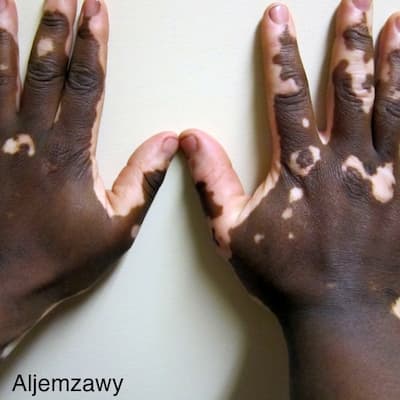vitiligo
Vitiligo is a disorder that affects the skin and appears on it smooth white patches, usually starting on the hands, feet and face.
 |
| A comprehensive file on Vitiligo in terms of: symptoms, types and treatment |
Its prevalence is low, as it affects about 10% of the world's population.
The areas where there is vitiligo are called macules if their area is less than 5 mm, but if they are more than 5 mm they are called spots.
The area affected by vitiligo becomes white in color and the color of the hair in it.
Vitiligo occurs after the immune system destroys the pigment cells that produce melanin, the substance that gives skin its colour.
Read about: Psoriasis and its treatment at home
Causes of Vitiligo
Although the direct cause of vitiligo is not clear, scientists have come up with several theories that explain the factors that lead to the appearance of vitiligo, namely:
- The immune system: it produces antigens that destroy melanocytes.
- Self-destruction: The melanocytes are damaged by a defect that causes them to self-destruct.
- Genetic factors: Heredity affects the transmission of vitiligo to later generations, as it was found that 30% of people with vitiligo have a previous genetic condition.
- Neurotrophic factors: Neurons release toxins toward melanocytes.
- Psychological and emotional state: Stress and physical and emotional fatigue may be one of the reasons for the occurrence of vitiligo.
Vitiligo Symptoms
- The appearance of white spots in different areas of the body.
- Patches of hair turning white.
- Eyelashes and eyebrows discoloration.
- Discoloration of the mucous membranes inside the nose and mouth.
- Notice a change in skin color in skin folds such as the armpits.
- The appearance of vitiligo around moles.
Types of Vitiligo
- Partial Vitiligo: Vitiligo is localized in a specific area of the body, such as the face and hands.
- Focal vitiligo: In this type, vitiligo is concentrated on one area only and does not spread to other areas.
- Generalized Vitiligo: The discolored patches are scattered all over the body, and this is the most common type.
- Global Vitiligo: This is the most rare type, the skin is affected by 80% of Vitiligo.
- Trichrome Vitiligo: The skin is of a cow with a dark color, then a spot with a light color, followed by the original skin color.
Who are exposed to vitiligo?
age of onset of vitiligo
How long does vitiligo spread on the skin
Is vitiligo painful?
Is vitiligo contagious?
Is itching a symptom of vitiligo?
Problems associated with vitiligo
- Due to the loss of melanocytes, the white spots become more sensitive to sunlight, which results in burns and pain.
- It is possible for some people with vitiligo to suffer from problems in the retina and iris of the eye, such as inflammation in one of them, and this does not mean that vision is affected.
- Vitiligo increases the chance of some immune diseases such as: diabetes, hypothyroidism, alopecia, anemia.
- (People with immune diseases are more likely than others to develop vitiligo.)
- People's harassment and bad comments may cause feelings of embarrassment and the desire to isolate and stay away from others.
vitiligo treatment
- Skin re-dyeing
- Taking (corticosteroids) as pills or fats placed on the skin, used for three months until the results appear, with the doctor’s follow-up for any side effects that may appear during this period.
- Immunosuppressants such as calcineurin.
- Vitamin D treatment.
- light therapy
- surgery
Other treatments
- Use sunscreen to protect white spots from harmful rays.
- Make-up can be used to hide white spots.
- Dye the hair if the vitiligo has reached the hair of the head.
- The use of monobenzone and this treatment turns the color of the skin to white to suit white spots, It is used in extensive cases of vitiligo.
- Communicate with a psychiatrist to take advice to face critical situations.
Celebrities with
- Michael Jackson.
- Amitabh Bachchan.
- Rami Jamal.
- Chantel Brown.
- Holly Marie Combs.
